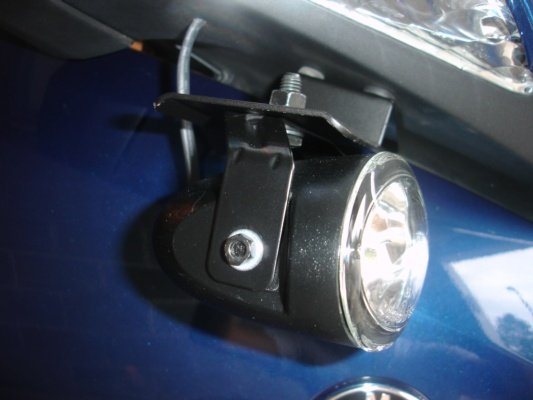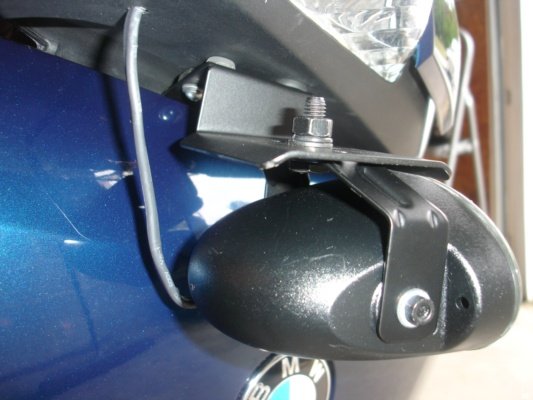Just added a pair of Hella FF50s on BMR brackets to my 08 RT - winter night riding is approaching. I picked this light because others (eg Don) have reported good experiences with it (though my prior experiences with Hella have not been so good) and because the TrailTech 30W HID lights on mine have so far proven to be extremely unreliable in even slightly adverse conditions, so I need something that actually will stay working. Photos and comments follow.
Re the Hella FF50 kit, price around $100. Except for the lights, kit quality is poor- not suited to proper wiring practice and having marginal to poor quality other parts. What you get is a long hunk of 16 gauge wire that is too thin for proper wiring, a non-waterproof switch, a non-sealed relay in the odd euro configuration (switched 30 and 86 terminal locations) that makes subbing protected relays problematic, and a handful of loose, non-insulated connectors. No shrink tube, no fuse, no relay socket, etc etc. Basically I threw it all out except the lights.
First- wire gauge choice. Good design practice is less than 3% voltage drop to the lights so you get full lumens you are paying for. Light output drops exponentially with voltage drops and the exponent is greater than 3 - the right wire size matters! There are voltage drop calculators you can find with a google search that will allow you to plug in wire lengths and gauges so you can see what your planned installation will deliver. You will quickly see that at least 14 gauge wire is needed for typical motorcycle lengths. I took power for my lights from my Eastern Beaver fuse panel (it runs off a 70A relay and is fed by much larger wire than anything going to the lights) on the rear fender so ran 12 gauge to a relay mounted in the front of the bike. 12 gauge is the largest size that clamps into the Eastern Beaver panel circuits and I fused it at 20A, the limit for a single circuit on the EB box and easily able to feed the 12-13A my bulbs will use. I ran 14 gauge from the relay to each FF50 light. All wiring is in shrink tube and/or loomed for weather and physical protection.
The relay I used is a more std config, sealed, and heavier duty Matsusithsa (spelled to get past the filter) and its trigger wire has a diode to isolate its coil switching voltage spikes from the bike wiring (these can reach 300-500V, are of very short duration and potentially dangerous to unprotected solid state devices). The relay is mounted in a socket- this makes it easy to unplug and change while preventing the possibility that some careless service person might swap connectors on it and fry something. In this case I chose to take the trigger from the hi beam wire so these FF50s will go on and off with my hi beam switch. That choice works for the way I intend to use them but some may prefer for them to have their own individual switch.
I selected Osram 65W H-7 bulbs, choosing not to use the std Osram 55W bulbs provided with the lamps. They're rated at 2100 lumens at 13.2 volts, a very large gain over the 55W ones, and are basically an H-9 bulb capsule in an H-7 base. They have normal rated service life (500 hr), unlike most hi output bulbs. I do not expect any issues from the moderate heat load increase having done this sort of swap many times in glass-lensed reflector lights like the FF50s but it will take a year or two of use to verify that with 100% certainty. Because I use the same Osram 65W bulbs in all 3 head light positions, carrying spares and even swapping is greatly simplified compared to having different bulb types in the various locations.
The BMR mounts were chosen because they give flexibility to mount various light options and stay away from just hanging the lamp in a hole in the plastic under the mirror which would be a bit too far rearward and too far to the outside for my taste.
Voltages were measured with my Fluke after installation (with all electric loads on the bike turned on) and confirmed that slightly in excess of 13.2V is present at the bulb terminals at operating rpms. Of course, it drops to mid 12s at idle speed. So the voltage drop target is met and full voltage is on tap.
See Don's website for output photos. For the size reflector these are they do a very nice job. Hella claims the FF reflector design captures much more light from the bulb than the parabolic shape used in some of their other lamps and by other brands and perhaps the FF design does indeed improve the efficiency of this design. In general, larger reflectors will outperform smaller ones with the same bulb by a pretty good margin but these FFs seem pretty respectable. Going through the light threads at ADVRider will show a lot of other users who like them.
Anyway, here is a photo of the install that also hows the TT30s on EzyMounts just under the oil cooler. The TTs are on a PIAA harness with their own switch. The camera angle is a high one, necessary to keep artifacts from being recorded by my digital camera (an old Sony PC-150) but it also makes my Photon Blasters look very dim which is not at all accurate- the angle is simply a bit hi and close to be in their output beam. You can also see the Barkbusters S-7s I added for winter riding with thin gloves- got a bit of a circulation problem in my right hand so the wind protection is useful.
Re the Hella FF50 kit, price around $100. Except for the lights, kit quality is poor- not suited to proper wiring practice and having marginal to poor quality other parts. What you get is a long hunk of 16 gauge wire that is too thin for proper wiring, a non-waterproof switch, a non-sealed relay in the odd euro configuration (switched 30 and 86 terminal locations) that makes subbing protected relays problematic, and a handful of loose, non-insulated connectors. No shrink tube, no fuse, no relay socket, etc etc. Basically I threw it all out except the lights.
First- wire gauge choice. Good design practice is less than 3% voltage drop to the lights so you get full lumens you are paying for. Light output drops exponentially with voltage drops and the exponent is greater than 3 - the right wire size matters! There are voltage drop calculators you can find with a google search that will allow you to plug in wire lengths and gauges so you can see what your planned installation will deliver. You will quickly see that at least 14 gauge wire is needed for typical motorcycle lengths. I took power for my lights from my Eastern Beaver fuse panel (it runs off a 70A relay and is fed by much larger wire than anything going to the lights) on the rear fender so ran 12 gauge to a relay mounted in the front of the bike. 12 gauge is the largest size that clamps into the Eastern Beaver panel circuits and I fused it at 20A, the limit for a single circuit on the EB box and easily able to feed the 12-13A my bulbs will use. I ran 14 gauge from the relay to each FF50 light. All wiring is in shrink tube and/or loomed for weather and physical protection.
The relay I used is a more std config, sealed, and heavier duty Matsusithsa (spelled to get past the filter) and its trigger wire has a diode to isolate its coil switching voltage spikes from the bike wiring (these can reach 300-500V, are of very short duration and potentially dangerous to unprotected solid state devices). The relay is mounted in a socket- this makes it easy to unplug and change while preventing the possibility that some careless service person might swap connectors on it and fry something. In this case I chose to take the trigger from the hi beam wire so these FF50s will go on and off with my hi beam switch. That choice works for the way I intend to use them but some may prefer for them to have their own individual switch.
I selected Osram 65W H-7 bulbs, choosing not to use the std Osram 55W bulbs provided with the lamps. They're rated at 2100 lumens at 13.2 volts, a very large gain over the 55W ones, and are basically an H-9 bulb capsule in an H-7 base. They have normal rated service life (500 hr), unlike most hi output bulbs. I do not expect any issues from the moderate heat load increase having done this sort of swap many times in glass-lensed reflector lights like the FF50s but it will take a year or two of use to verify that with 100% certainty. Because I use the same Osram 65W bulbs in all 3 head light positions, carrying spares and even swapping is greatly simplified compared to having different bulb types in the various locations.
The BMR mounts were chosen because they give flexibility to mount various light options and stay away from just hanging the lamp in a hole in the plastic under the mirror which would be a bit too far rearward and too far to the outside for my taste.
Voltages were measured with my Fluke after installation (with all electric loads on the bike turned on) and confirmed that slightly in excess of 13.2V is present at the bulb terminals at operating rpms. Of course, it drops to mid 12s at idle speed. So the voltage drop target is met and full voltage is on tap.
See Don's website for output photos. For the size reflector these are they do a very nice job. Hella claims the FF reflector design captures much more light from the bulb than the parabolic shape used in some of their other lamps and by other brands and perhaps the FF design does indeed improve the efficiency of this design. In general, larger reflectors will outperform smaller ones with the same bulb by a pretty good margin but these FFs seem pretty respectable. Going through the light threads at ADVRider will show a lot of other users who like them.
Anyway, here is a photo of the install that also hows the TT30s on EzyMounts just under the oil cooler. The TTs are on a PIAA harness with their own switch. The camera angle is a high one, necessary to keep artifacts from being recorded by my digital camera (an old Sony PC-150) but it also makes my Photon Blasters look very dim which is not at all accurate- the angle is simply a bit hi and close to be in their output beam. You can also see the Barkbusters S-7s I added for winter riding with thin gloves- got a bit of a circulation problem in my right hand so the wind protection is useful.
Attachments
Last edited:



